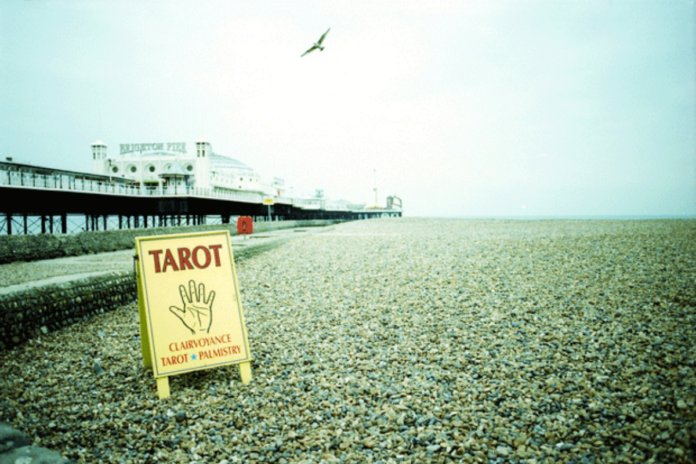Tarot reading remains a marginalized cultural practice, yet it continues to draw interest from educated secular intellectuals. What is the allure behind it?
Madam Sosotris, famous clairvoyante
Had a bad cold, nevertheless
Is known to be the wisest woman in Europe
With a wicked pack of cards.
T. S. Eliot
Also Read: Armed With Words (Yemen)
Exploring The Waite Rider Tarot Deck
During a brief period influenced by the hippie movement, a friend introduced me to tarot cards. Soon, I found myself practicing with spreads like the Celtic Cross and triangular layouts using the Waite Rider deck. Created in 1909 by artist Pamela Colman Smith under the influence of occultist A. E. Waite, this deck reflects the widespread interest during the late Victorian era in groups like The Hermetic Order of the Golden Dawn, a prominent occult organization at the time.
Unlike traditional decks such as the Tarot de Marseille, where only the Major Arcana cards are illustrated, the Waite Rider deck features pictorial representations on every card, including the Minor Arcana. These colorful and visually appealing images, characterized by an Arts and Crafts and Art Nouveau style with medieval influences, sparked my imagination and resonated with the spiritual and divinatory aspects of tarot reading.
Though fortune-telling is often dismissed as a frivolous pursuit, it holds a historical reverence and persists with an air of mystery. Even in modern times, there remains a certain enigmatic allure surrounding the practice, with some adherents treating it as a sacred tradition steeped in legends and lore.
The Fabrication Of Tarot’s History By Nineteenth-Century Occultists
In their extensive two-volume history of the tarot, Ronald Decker and Michael Dummett meticulously detail the creation of a false narrative surrounding the origins of the tarot. Particularly emphasized in the second volume, titled A History of the Occult Tarot, 1870–1970, is the construction of an elaborate mythos by nineteenth-century occultists. Despite lacking credible historical evidence, these individuals purported to trace the tarot’s legend back to ancient Egypt.
It remains uncertain to what extent these purveyors of fantasy believed their own fabrications. However, for many, the manufactured legends held a profound allure, rivaling the narratives of established religions like Christianity. Drawing upon these concocted histories, the Waite Rider pack also incorporates elements from Egyptian, Christian, and Greek myths and legends.
The Utility Of Tarot Cards In Problem-Solving
While skeptical about the ability to predict the future, I find value in using tarot cards to contemplate personal issues. As a friend aptly expressed, the imagery on the cards can serve as prompts, much like Rorschach test cards, stimulating thoughts and insights regarding one’s dilemmas.
Even in the most casual settings, such as on a resort pier, where fortune-telling may seem mundane, a sense of ritual can evoke a range of emotions, from a hint of foreboding to a form of meditative reflection. In either case, engaging with tarot cards represents a distinct practice with the potential to offer valuable insights into one’s life challenges.
During the late 1980s and 1990s, I occasionally offered tarot readings at fundraising events. Initially, these events were in support of feminist causes, later transitioning to school jumble sales. Despite the varying causes, I consistently found many customers seeking readings. While there was a degree of reluctance or denial regarding the seriousness of tarot, it was never solely perceived as entertainment.
Drawing upon skills acquired as a mental health worker, I delved into personal narratives of domestic struggles, job insecurities, and aspirations for change. Some individuals even expressed a desire for private consultations, assuming I was an established clairvoyant.
This assumption troubled me, prompting concerns about the ethical implications of my involvement in fundraising events. Eventually, these requests led me to discontinue my participation in fundraising activities as I grappled with the ethical complexities inherent in providing tarot readings within such contexts.
Ethical Considerations Of Offering Tarot Reading
Contemplating the idea of setting up shop at Lock Market or Brighton’s seafront, I couldn’t help but entertain the possibility of earning additional income effortlessly. The allure of providing tarot readings intrigued me, considering that Freudian psychoanalysis, with its origins intertwined with the enigmatic depths of the unconscious mind, once held similar associations of the dubious and occult.
However, I refrained from making predictions during readings; instead, I relied on my observational and interviewing skills to uncover what the individual needed to discuss and how I could assist them. While it is legally permissible for anyone to establish themselves as a psychotherapist, regardless of formal training, I grappled with ethical concerns regarding my own practice.
Despite potentially offering beneficial insights, I questioned the integrity of my approach, as I did not subscribe to spiritualism or claim to possess psychic abilities. This dilemma raised ethical considerations regarding the authenticity and honesty of my interactions with clients.
Abandoning The Pursuit Of A Clairvoyant Career
The notion of embarking on a new career as a clairvoyant ultimately lost its appeal for me. I recognized that success in such a field required a serious commitment and dedicated effort to hone the skills of observation and intuition upon which it relies.
Essentially, one would need to adopt the role of a therapist, albeit without the backing of established associations like the Association of Psychotherapists or the British Psychoanalytical Association.
While there may exist societies or communities of clairvoyants, such as the Order of the Golden Dawn, I felt no inclination to immerse myself in any occult circles.
Despite my reservations, I still find myself drawn to the allure of tarot. Engaging with the cards creates a liminal experience, straddling the realms of imagination and reality. Each card serves as a conduit to explore various emotional states and perceptions.
One need not adhere to occult beliefs to appreciate the allegorical representations of themes like power, love, despair, and hope depicted in the cards. They offer a unique lens through which to reflect on one’s life, residing in the interstice between playful exploration and deeper, hidden meanings.
Attraction Of Tarot For The Non-religious
The allure of tarot may lie in its capacity to evoke an “enchanted realm,” providing a sense of escape from societal constraints, commonly referred to as the “iron cage,” without imposing rigid moral doctrines akin to established religions. In the 1980s, I observed a surprising number of feminists identifying with their astrological star signs, indicating a broader interest in mystical or spiritual practices.
This observation was echoed in the obituary of psychic astrologer Henrietta Llewelyn Davies, published in The Telegraph on May 20, 2011. Davies claimed to possess psychic abilities, studied astrology in India, and wrote horoscopes for various publications. She garnered a clientele of well-known individuals, offering advice on a wide array of topics.
However, despite her popularity, the obituary received predominantly negative comments from readers, expressing disdain for what they perceived as belief in “dark ages superstition.” Some commenters drew parallels with organized religion and criticized the education system for fostering such credulity.
The Attraction Of “Magical” Realms To Educated Secular Intellectuals
Many wonder why educated secular intellectuals are drawn to realms of magic and mysticism. As a non-believer myself, I perceive all myths as equally significant – if they are imaginative and resonate with us, they hold value, though one should not take them as literal truth. Karen Armstrong, in her work “The Case for God,” presents a similar perspective regarding Christianity.
She suggests that Christianity, influenced by its encounters with science, has become pseudo-scientific, with believers seeking “facts about God” and insisting on the Bible’s literal truth. Instead, Armstrong proposes that religion should be viewed as a practice, a discipline cultivating perception through imagination and empathy, which, supported by rituals and practices, can still evoke a sense of transcendence.
According to her, religion is essentially about feeling, echoing Ludwig Feuerbach’s observation that God is a projection of human emotion. Thus, if a belief system resonates emotionally, it holds an “emotional truth,” regardless of the literal accuracy of its stories. This perspective aligns with postmodern religion, where the truth of its propositions becomes irrelevant.
It suggests that engaging with the tarot, akin to Christian observance, validly expresses this receptive state induced by art. However, whether Armstrong would equate practicing the tarot with following a well-established and influential religion remains.
Karen Armstrong’s Perspective On Subjectivity And Belief
Karen Armstrong’s perspective challenges the notion that certain beliefs, such as faith in the occult or ghosts, or even being a fan of Judy Garland, are less valid than traditional religious convictions like belief in the Trinity.
From her viewpoint, if faith and belief are fundamentally subjective, then all beliefs, whether socially sanctioned or not, hold equal validity. This perspective extends to cultural preferences, suggesting that reading Marcel Proust can be as valuable as studying the Bible.
It’s not a defense of subjectivism per se but rather an acknowledgment that all sets of beliefs in the supernatural lack rational and evidential support. Conversely, regardless of their veracity, many belief systems contain myths and imaginative elements that stimulate the imagination, enhance understanding, and illuminate truths through metaphor.
Additionally, nostalgia is viewed as more than mere sentimentality; it’s seen as a projection of the past or a longing for transcendence.
 Elizabeth Wilson, author of “Cultural Passions: Fans, Aesthetes and Tarot Readers,” has also written acclaimed works such as “Adorned in Dreams: Fashion and Modernity” and “Bohemians: The Glamorous Outcasts.” Alongside her academic pursuits, she has delved into crime fiction with novels like “The Twilight Hour,” “War Damage,” and “The Girl in Berlin.” Wilson currently holds a Visiting Professorship in Cultural Studies at the London College of Fashion, part of the University of the Arts London.
Elizabeth Wilson, author of “Cultural Passions: Fans, Aesthetes and Tarot Readers,” has also written acclaimed works such as “Adorned in Dreams: Fashion and Modernity” and “Bohemians: The Glamorous Outcasts.” Alongside her academic pursuits, she has delved into crime fiction with novels like “The Twilight Hour,” “War Damage,” and “The Girl in Berlin.” Wilson currently holds a Visiting Professorship in Cultural Studies at the London College of Fashion, part of the University of the Arts London.
Also Read: The Suicide of Judas in Medieval Art


